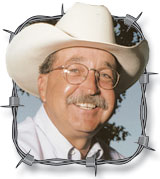Once I told Judd McKnight, the great sheep rancher of Roswell, N.M., my plans to complete grassland research on my own farm, in search for a Western grass that could adapt itself to Ozarks conditions. My interest in this venture whetted, I began watching closely other, similar developments. It was the first year of the old Soil Banks, and I saw a man take the worst rundown field in Greene County, plow it up, lime it and bring up the fertility count, and plant fescue. Despite the progress of my Western grasses, they were mere shadows of the neighbor’s fescue, so, while I didn’t intend to plow up my experimental plot, I determined to put my entire farm in fescue, never again to grow a row crop and not even to put up hay. I reasoned that I could devote what would have been hayland to cows, and use the profit from the cows to buy hay for the entire herd. My machinery would consist of one tractor, one mower, one wagon and a pull-type combine to get the seed off my fescue.
But where to get the money to renovate one acre, much less several hundred? There was only one answer – The Soil Bank. Putting half the farm under contract, I began renovation. The following year I used my soil bank check to put most of the rest of the place in fescue.
The Western grasses began, one by one, to “peter out.” The wheatgrasses flat died. Sideoats and blue grama grew meagerly but were not aggresive. Buffalo grass seemed adapted and spread beautifully, but obviously would not produce enough forage in a “small” country to justify itself. Sand lovegrass, while beautiful and tender, couldn’t hold its own with more agressive weeds. Weeping lovegrass proved it would grow where nothing else would, but its leaves were tough as broomstraw, and I doubted that anything would eat it (I later discovered differently, however). Blue panic looking promising – but sorghum almum was great. It made the most lush forage I ever saw. To test its palatability, I turned the cows into the garden patch. I was happy when they went directly to the sorghum almum. “This is it,” I said. “We’ve found the summer grass we want to go with the fescue for fall, winter and spring.”
No sooner had I said it than, boom! Down went three cows. Fortunately, I had the proper drug on hand and saved the cows with a shot in the jugular veins. While I was pumping the stuff in the veins, Andy was driving the other cows back into the lot. When the gate was shut, I yelled, “Get the tractor and plow up that damned stuff!”
Eight years later, I was still fighting sorghum almum. Although it did not spread, it continued to grow where I first planted it. Perhaps I should have used it for a silage crop. What a boon it would have been to have a perennial silage crop!






